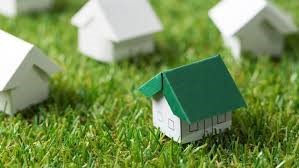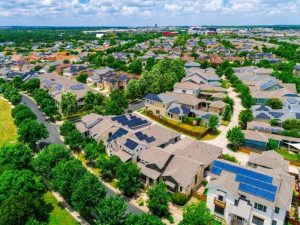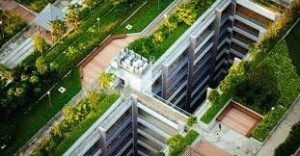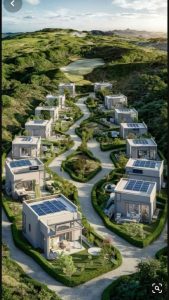Introduction:
As environmental concerns become increasingly important, the demand for sustainable homes has surged across California. The Golden State, known for its progressive environmental policies, is leading the charge in promoting green real estate. With rising awareness of climate change, energy consumption, and resource conservation, many homebuyers are now seeking homes that reflect their values of sustainability. This blog will explore the rise of sustainable homes in California, their key features, the financial benefits, and the future of green real estate in the state.

The Growing Importance of Sustainable Homes in California:
California has long been at the forefront of environmental policy, and this extends to its real estate market. The state’s commitment to reducing carbon emissions, conserving water, and adopting renewable energy sources is reshaping the way homes are built and purchased. With its ambitious sustainability goals, California has set the stage for a green revolution in the housing market.
California’s green building standards are some of the most rigorous in the country, and more homebuyers are prioritizing energy-efficient and eco-friendly features when making purchasing decisions. The rise of energy-efficient homes, solar-powered homes, and net-zero homes is not just a trend—it’s the future of real estate in the state.
Key Features of Sustainable Homes:
What makes a home truly sustainable? Several features set eco-conscious homes apart from traditional properties, and they play a significant role in reducing environmental footprints while enhancing energy efficiency.
- Energy Efficiency:
One of the defining characteristics of sustainable homes is energy efficiency. From energy-efficient appliances to superior home insulation, these homes are designed to use less energy while still providing comfort and functionality. Many homes are equipped with solar panels to generate clean energy, reducing reliance on traditional energy sources and lowering utility bills. In fact, solar-powered homes can significantly reduce or even eliminate monthly energy costs, making them a smart investment for long-term savings.
- Water Conservation:
California is no stranger to droughts, which makes water conservation a top priority in sustainable home design. Homes with low-flow fixtures, drought-tolerant landscaping, and efficient irrigation systems are essential for reducing water consumption. These homes not only help conserve the state’s limited water resources but also lower homeowners’ water bills.
- Sustainable Building Materials:
Eco-friendly building materials are another hallmark of sustainable homes. Materials like recycled steel, bamboo, and cork are commonly used to reduce environmental impact. Additionally, homes may feature non-toxic paints and low-VOC (volatile organic compounds) materials to ensure healthier indoor air quality.
- Smart Home Technology:
Integrating smart home technology is an effective way to improve a home’s sustainability. Smart thermostats and energy monitoring systems allow homeowners to track their energy usage in real time, adjust settings, and make informed decisions to optimize energy efficiency. This helps further reduce energy waste and ensures that the home operates in the most efficient way possible.

The Financial Benefits of Sustainable Homes:
While sustainable homes may have a higher upfront cost, the long-term financial benefits are significant.
- Energy Savings:
Energy-efficient homes can save homeowners a substantial amount of money on monthly utility bills. By using energy-efficient appliances, better insulation, and solar panels, homeowners can significantly reduce their energy consumption. Many green homes are designed to be net-zero homes, meaning they produce as much energy as they consume. As a result, homeowners may see little to no energy costs over time.
- Government Incentives and Tax Credits:
California offers various incentives for those purchasing green homes. Buyers of solar-powered homes may qualify for state-level tax incentives and rebates for installing renewable energy systems. Additionally, there are federal and state programs that provide tax credits for homeowners who make energy-efficient upgrades, such as replacing old windows or upgrading insulation. These incentives can help offset the initial cost of purchasing or retrofitting a green home.
- Increased Home Value:
Homes with green certifications, like LEED certification or Energy Star ratings, often have a higher resale value. Buyers are willing to pay a premium for homes that offer long-term savings through energy efficiency and sustainability. The added value of a sustainable home can make it a worthwhile investment for buyers looking to maximize their return when selling the property.
Green Certifications and Standards:
Several certifications ensure that a home meets the highest standards of sustainability and energy efficiency. These certifications can help buyers determine if a home truly qualifies as “green.”
- LEED Certification:
The Leadership in Energy and Environmental Design (LEED) certification is one of the most well-known green home certifications. Homes that earn LEED certification are built with sustainable materials, are energy-efficient, and prioritize water conservation and indoor air quality.
- Energy Star Certification:
Homes with the Energy Star label have been evaluated and verified to meet specific energy performance standards. These homes are equipped with energy-efficient appliances, insulation, and windows that significantly reduce energy consumption.
- Net Zero Homes:
A net-zero home generates as much energy as it consumes over the course of a year. These homes typically incorporate solar panels and energy-efficient designs that minimize energy waste. With the rise of renewable energy technologies, net-zero homes are becoming an increasingly popular choice for eco-conscious homebuyers.

Challenges of Purchasing a Sustainable Home in California:
While the benefits of sustainable homes are clear, there are challenges to consider.
- Initial Cost:
The upfront cost of purchasing a green home can be higher than a traditional home. Sustainable building materials, energy-efficient systems, and renewable energy installations can increase the price. However, financing options such as green home loans and government incentives can help offset these costs.
- Availability of Green Homes:
In some areas, it can be challenging to find homes that meet sustainable building standards. However, the growing popularity of green real estate means that more homes are being built with eco-friendly features. Buyers may need to work with a real estate agent who specializes in eco-conscious real estate to find the right property.
The Future of Green Real Estate in California:
The future of green real estate in California looks bright. As technologies continue to improve, more homes will incorporate advanced smart home technology, solar power, and other sustainable features. The state’s ambitious environmental goals and growing demand for eco-friendly homes will likely lead to continued growth in the green real estate market.
Additionally, local governments are becoming more supportive of sustainable building practices, offering programs that make it easier for homeowners to adopt green features. Communities are also adopting green construction practices and promoting sustainable home ownership through education and incentives.

Conclusion:
Sustainable homes are no longer a niche market in California—they are the future of real estate. With the state’s commitment to sustainability and the growing demand from eco-conscious buyers, green homes are becoming more accessible and desirable. From solar-powered homes to energy-efficient appliances, these homes offer both environmental and financial benefits. As green building technologies continue to evolve, California is paving the way for a more sustainable and energy-efficient real estate market. Whether you’re looking to purchase a home now or in the future, embracing green living is a wise investment for both the planet and your wallet.

